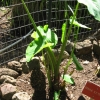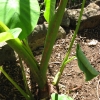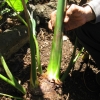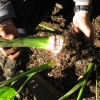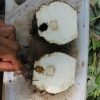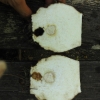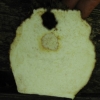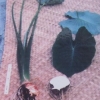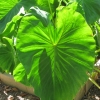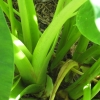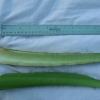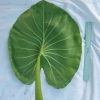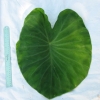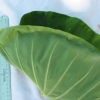Use As Food
Mainly eaten as a table taro; one of the favorite varieties for making kulolo. The taro has excellent quality as table taro. The Mana and the Lauloa taros are used in preference to all others for making the Hawaiian pudding kūlolo, a combination of grated taro and coconut milk.
Distribution
Grown extensively in Kona, Hawai‘i, almost exclusively under dryland culture (māla).
General Characteristics
Medium in height, erect, maturing within 7 to 12 months, producing two or three branches; characterized by dark green hā (petiole) with distinct pinkish-red edges.
Ha (Petiole)
60 to 85 cm. long, dark green, distinctly pinkish-red at edge, white at kōhina (base).
Lau or Lu'au(Leaf Blade)
40 to 55 cm. long, 20 to 40 cm. wide, 30 to 40 cm. from tip to base of sinus (māwae), egg-shaped (ovate), thin in texture, medium green; margins wave-like (undulate); piko small, yellowish; round leaf section (lobes) obtuse, often overlapping, with narrow lihi māwae (sinus).
'I'o kalo (Corm)
Flesh chalky white with yellowish fibers; skin white, light lilac-pink to purple at leaf scars.
Pua (Flower)
Remarks
This is probably the most popular of the Mana, due to its large ‘i‘o kalo (Corm) and ability to produce good yields even under difficult conditions.



